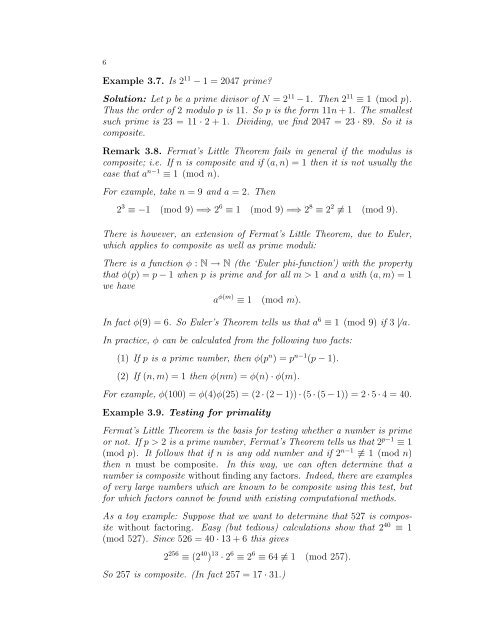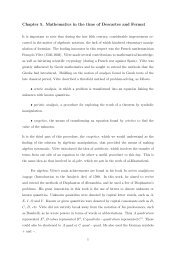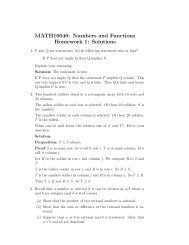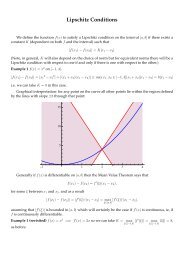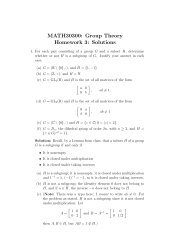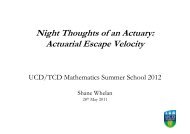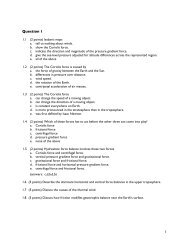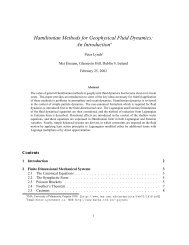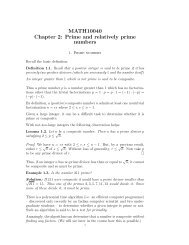MATH10040 Chapter 5: Fermat's 'Little' Theorem
MATH10040 Chapter 5: Fermat's 'Little' Theorem
MATH10040 Chapter 5: Fermat's 'Little' Theorem
Create successful ePaper yourself
Turn your PDF publications into a flip-book with our unique Google optimized e-Paper software.
6Example 3.7. Is 2 11 − 1 = 2047 prime?Solution: Let p be a prime divisor of N = 2 11 − 1. Then 2 11 ≡ 1 (mod p).Thus the order of 2 modulo p is 11. So p is the form 11n + 1. The smallestsuch prime is 23 = 11 · 2 + 1. Dividing, we find 2047 = 23 · 89. So it iscomposite.Remark 3.8. Fermat’s Little <strong>Theorem</strong> fails in general if the modulus iscomposite; i.e. If n is composite and if (a, n) = 1 then it is not usually thecase that a n−1 ≡ 1 (mod n).For example, take n = 9 and a = 2. Then2 3 ≡ −1 (mod 9) =⇒ 2 6 ≡ 1 (mod 9) =⇒ 2 8 ≡ 2 2 ≢ 1 (mod 9).There is however, an extension of Fermat’s Little <strong>Theorem</strong>, due to Euler,which applies to composite as well as prime moduli:There is a function φ : N → N (the ‘Euler phi-function’) with the propertythat φ(p) = p − 1 when p is prime and for all m > 1 and a with (a, m) = 1we havea φ(m) ≡ 1 (mod m).In fact φ(9) = 6. So Euler’s <strong>Theorem</strong> tells us that a 6 ≡ 1 (mod 9) if 3 ̸| a.In practice, φ can be calculated from the following two facts:(1) If p is a prime number, then φ(p n ) = p n−1 (p − 1).(2) If (n, m) = 1 then φ(nm) = φ(n) · φ(m).For example, φ(100) = φ(4)φ(25) = (2 · (2 − 1)) · (5 · (5 − 1)) = 2 · 5 · 4 = 40.Example 3.9. Testing for primalityFermat’s Little <strong>Theorem</strong> is the basis for testing whether a number is primeor not. If p > 2 is a prime number, Fermat’s <strong>Theorem</strong> tells us that 2 p−1 ≡ 1(mod p). It follows that if n is any odd number and if 2 n−1 ≢ 1 (mod n)then n must be composite. In this way, we can often determine that anumber is composite without finding any factors. Indeed, there are examplesof very large numbers which are known to be composite using this test, butfor which factors cannot be found with existing computational methods.As a toy example: Suppose that we want to determine that 527 is compositewithout factoring. Easy (but tedious) calculations show that 2 40 ≡ 1(mod 527). Since 526 = 40 · 13 + 6 this gives2 256 ≡ (2 40 ) 13 · 2 6 ≡ 2 6 ≡ 64 ≢ 1 (mod 257).So 257 is composite. (In fact 257 = 17 · 31.)


